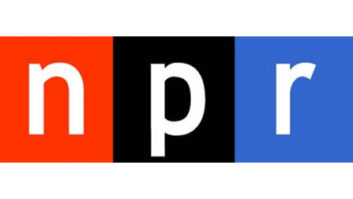In the first half of this paper (Engineering Extra, Apr. 14), I discussed the need for an accurate antenna capable of repeatable measurements and presented the design of NPR Lab’s transportable ground plane antenna. The article also described some early measurement techniques for VHF FM that set standards for quality, worth emulating today some 60 years later.
However, the old techniques used a series of local spot measurements that were collected along a common transmitter radial. These separate measurements were plotted on a signal strength vs. distance chart and fitted with curve. The position and shape of the curve, relative to the FCC’s signal propagation curve, indicated antenna radiation performance in a given direction and terrain effects at the coverage fringe. This approach though wasn’t suited to “drive-test” studies over wide areas, which NPR needed in order to evaluate and compare HD Radio coverage to analog FM service.
Fortunately, we now have computers and software tools to help continuously collect and process the volume of data along hundreds of miles of roadway.
NPR Labs needed to carry out measurements of HD Radio signal coverage, specifically to determine how interference received from stations on first- and second-adjacent channels would affect digital reception. This required a customized measurement system. Drive test measurement adds some requirements that were not necessary in the original systems, especially in view of a tight schedule and limited budget. (See chart.)

The requirements were a tall order, as the middle column entries show. There was no commercially-available unit that met our requirements, so in NPR Labs tradition, we built our own field test unit. This unit provided all the features and performance summarized in the right column.
The following will describe how we set up the units for measurement, calibrate them and use them for field strength measurement.
NPR Labs had some early experience with the Kenwood KTC-HR100 “black box” tuner, as it was the first commercially-available HD Radio receiver. Although a complete tuner, the box required a Kenwood in-dash head unit to provide the tuning controls, display and loudspeaker amplifier. We used one in NPR’s “Tomorrow Radio” drive test work in 2002, to record coverage in a number of cities around the country. We used a proprietary computer interface to connect to the tuner, and the interface required proprietary software to record the data. While it worked well, the reception status and GPS data logs were kept in separate files, and no information was available for field strengths, which we determined was necessary to build a model for HD Radio coverage prediction.

Fig.1: This chart shows Kenwood tuner DC output vs. RF signal input. With the calibrated groundplane antenna, a maximum input of –30 dBm is more than 80 dBu field strength. Signals or channel noise as low as 10 dBu are measurable. Fortunately, a little “reverse engineering” of the black box yielded a breakthrough. The voltage at a certain point on the receiver board provided a near-linear presentation of the input signal power over a 70 dB range! Fig. 1 shows the DC output voltage vs. FM RF input referenced to 50 ohms, from –25 dBm down to –104 dBm.
It’s apparent that the signal voltage flat-tops above –30 dBm, and there is a slight curve at the lowest signal powers. The voltage would be fine as is, but we extend the range of accuracy by using a cubic spline formula to track the curves. When attached to our ground plane antenna, this results in an accurate measurement from approximately 80 dBuV to nearly 10 dBuV. While the upper limit would prevent measurement at higher field strengths closer to test stations, we have focused on lower field strengths that are pertinent to station interference and which correlate nicely to the native range. If we needed measurements at higher signal levels, we inserted a fixed 50-ohm pad into the antenna line.
The Kenwood tuner provides only the signal strength of the analog host FM station, but the frequency difference between the FM carrier and each digital subcarrier group is less than 150 kHz. At FM Band frequencies this difference is less than 0.17 percent (0.15/88.1 = 0.0017), which causes a high correlation of fading between the analog and digital signals. Consequently, a station’s analog FM field strength is an accurate “proxy” for the station’s digital field strength. This condition would not apply to stations that have different analog and digital antenna radiation patterns, but we avoided this type of station in our nationwide measurement campaign used to develop a prediction model for HD Radio reception.

Fig. 2: Dual-trace oscillograph of the tuner’s unfiltered output voltage (upper half) with fast fading from lab’s Rayleigh simulator. Peak-to-peak RF range is approximately 25 dB. The lower trace shows the DC output after low-pass filtering. The average voltage is preserved, but the variations are greatly reduced. FAST FADES
Another important consideration in drive-test measurement of VHF signals is fast fading, which is caused by reflections from the foreground surface near the vehicle, distant hills or mountains, buildings, etc. The multipath causes the mobile signal to vary large amounts, often more than 20 dB, within the span of one wavelength (about 3 meters at FM frequencies). This effect dominates the variation in field strengths over the short distances that we refer to as the “local mean field strength.” These distances for “local mean field strength” may be 100 to 300 meters, and correlate to the cell sizes we use in our computer predictions of field strength. While we could potentially sample at high rates to quantize this fast fading, then average the results, this process requires a lot of data storage and post-processing, which is wasteful when the local mean field is what we want.
To reduce the sampling rate and storage of fast fading, we filter the signal in real time, using a four-pole low-pass filter having a 1 Hz cutoff. This is implemented with conventional op-amp ICs with a Butterworth characteristic. Fig. 2 shows a dual-trace oscilloscope photo of the DC voltage before filtering, using a mobile signal generated by the lab’s HP-11759C RF channel simulator. In the upper trace, familiar rounded peaks and sharp signal drops are representative of fast fading, which is also termed Raleigh fading, from the statistical probability distribution of fast fading. In the lower trace of Fig. 2, after the low pass filter, fast fading is almost gone and only the slower fading is left. The slower fading would reveal the effects of terrain shielding and land cover on signal strength that we are attempting to measure. The slow fading is referred to as log-normal fading, again getting its name from the statistical distribution of the signals over large geographic areas.

Fig. 3: Simplified diagram of the NPR Labs Field Test Unit, containing the Kenwood KTC-HR100 FM/AM/HD Radio tuner and EZ-500 control unit. The G-Dyno logger board with its MMC card socket is connected to the tuner through the low-pass filter (not shown). A digital voltmeter displays the DC signal line. A 12 volt sealed lead-acid battery, also not shown, provides backup against power interruptions and portable operation. The log-normal fading, representing the local mean field strengths we wish to capture, is sampled by a microcomputer logger inside the Field Test Unit’s cabinet. We wanted a logging device with removable flash memory storage, to provide a simple, self-contained measurement system and to avoid connecting laptops and running custom software. Finding the right logger wasn’t easy, when it had to combine a compact analog-to-digital sampler with integrated GPS capability. We finally located a company based in Scotland that makes a computer logger for race cars, called the “G-Dyno Plus.” The logger is only 3 by 6 inches and has seven A/D input channels. It also has four binary digital input channels, which made it perfect to record the Kenwood tuner’s digital blend line. The G-Dyno logger required software modifications by the manufacturer to change the sampling rate (we chose 4 Hz) and the output data format to we needed for signal post-processing.
The logger stores the RF signal values, digital receive status, UTC time stamps and GPS latitude and longitude to an MMC memory card (similar to SD cards).

Fig. 4: The main Field Test Unit’s features.
1 – Digital Volt Meter (for real-time Received Signal Level and power supply status)
2 – Controls and Indicators (from left to right) Main Power Switch, Logger Power Button, Logger Start/Stop Button
3 – 1/4″ Headphone Out
4 – 1/8″ Headphone Out
5 – Terminal Block for External Loudspeakers (4 x 20W)
6 – Headphone Level Control
7 – Preamp-Level Stereo Output Jacks
8 – Power Input Jack
9 – MMC Card Slot
10 – Global Positioning System (GPS) Jack
11 – FM Antenna Input Jack
12 – Kenwood EZ-500 Receiver Head Unit (controls internal KTC-HR100MC tuner) A simplified diagram for the field test unit is shown in Fig. 3. Inside the field test unit cabinet, the logger board is connected to the Kenwood KTC-HR100 “black box” tuner, which supplies the RF level and digital receive status signals. The connector for the external GPS unit and control buttons are brought to the front panel of the cabinet. The Kenwood EZ-500 control unit, mounted on the cabinet front, is connected to the tuner and provides a variety of audio outputs. Fig. 4 is a photo of the basic field test unit, pointing out the front-panel controls and connections.
MULTIPLE CHANNELS
To develop a model to predict the coverage of HD Radio (NPR Labs completed this model and has a patent pending), we realized that the original field test units’ single channel wasn’t enough.
We were estimating the field strength of the HD Radio signal by measuring the FM Host carrier (something that is well-correlated with the signal level of both sidebands, due to their close frequency adjacency). However, HD Radio employs two separate sidebands approximately 100 to 200 kHz from the FM carrier, squarely in the channels of upper and lower first-adjacent stations. To understand the behavior of HD Radio in the real world, we needed four receivers: one to provide field strength data on the desired host FM channel, one to determine the digital reception status and two to capture signal strength data on the lower first-adjacent channel and the upper first-adjacent channel.
The small size of the Kenwood black box tuners offered the opportunity to combine the three tuners, which collect the signal strengths of the host FM and upper and lower channels, into one separate cabinet. Rather than use three bulky head units, Kenwood offered a small tuner control that was no larger than a candy bar. (The auxiliary cabinet containing three tuners with the small tuner controls can be seen in the inset photo in the first article.)
(click thumbnail)
Fig. 5: The multichannel RF logging system used a standard Field Test Unit (FTU #1), equipped with a triple-input connector to interface with a second unit (FTU #4), modified to contain a total of three KTC-HR100 tuners. This unit also contains an 88–108 MHz bandpass filter, high dynamic range RF amplifier and four-port RF splitter. For NPR Labs’ recent HD Radio interference field tests, the three tuners were set to the desired channel and upper and lower first-adjacent channels, while the fourth RF output was fed to an OEM car radio, tuned to the desired channel, for analog audio recordings. Fig. 5 shows an actual diagram of the in-vehicle system used in 2009 for a series of over-the-air interference studies involving first-adjacent digital stations with analog FM reception. The left box is a field test unit containing a high-performance 88–108 MHz bandpass filter, a low-noise high dynamic range amplifier, and a precision four-port RF splitter. Three of the ports feed the three receivers in the auxiliary cabinet, which are connected through a multi-wire cable to the logger in basic field test, shown in the center. The fourth RF output was fed to an analog mobile FM receiver in this particular test for audio recording of off-air reception.
Returning to the system’s use for IBOC reception studies, a drive-test of WJFK(FM), Manassas, Va., a Class B commercial station on 106.7 MHz near Washington, is shown in Fig. 6. The graph illustrates approximately four hours of drive-test measurement on highways and arterials in southern Maryland and northern Virginia. This figure shows the signal power in dBm for WJFK (which operated in hybrid digital at –20 dBc at the time) as the dark blue line near the bottom of the chart. Note that even with the low-pass filtering, the log-normal fading causes substantial signal variation when viewed over longer periods.
WJFK has a first-adjacent neighbor, WWMX, a Class B on 106.5 MHz in Baltimore, and another first-adjacent neighbor, WWEG, a Class B on 106.9 MHz in Myersville, approximately 60 miles west of Baltimore and 50 miles northeast of WJFK.


Fig. 6: Signal power measurements in dBm from four hours of drive-testing outside Washington and in Maryland and northern Virginia for station WJFK(FM), a Class B on 106.7 MHz in Manassas, Va. WJFK’s signal is shown in dark blue trace along the bottom. Signals from WWEG, a Class B on 106.5 MHz in Myersville, Md., and WWMX, a Class B in Baltimore on 106.9 MHz are recorded in yellow and magenta, respectively. A desired-to-undesired signal ratio between WJFK and WWEG or WWMX, whichever is higher, is calculated and displayed as “min D/U” in gold, near the top of the chart. IBOC digital reception status is shown as the lighter blue trace near the 0 dB line; a “high” indicates digital reception and a “low” indicates no digital reception. Over most the route, the station signals vary independently, with WJFK’s digital reception dropping near the middle portion of the route. While the “min D/U” is an approximate indicator of successful IBOC reception, computer analysis of the numeric data presented here showed that a more complex relationship between the absolute level of WJFK and its ratio to both station signals was needed to determine whether IBOC would be received. WWMX’s signal is shown in yellow (–1 channel) and WWEG is shown in magenta (+1 channel). It’s apparent that the three signals can track differently in strength along the routes, depending on the distances and various terrain effects from each station. Signal powers varied from a high of approximately –30 dBm, where WJFK’s signal began to flat top, to lows close to –100 dBm. Where WJFK’s signal rises significantly, WWMX’s and WWEG’s signals rise too. This is due to 25 dB crosstalk from first-adjacent signals in the tuners. However, this level of measurement isolation was sufficient to collect all the data we needed to develop the HD Radio coverage prediction model.
Two more traces of data are presented on Fig. 6. A “max D/U” is shown in gold, representing the worst (lowest) desired-to-undesired signal ratio between WJFK and WWMX or WWEG are shown. It’s apparent that during the middle of the drive that WJFK’s signal becomes weaker than both stations’ signals, putting the gold trace below –20 dB. Near the beginning and end of the drive, the D/U ratios are nearer to +20 dB.
The last trace to view is in bright blue, near the “0 dB” level, presenting the digital receive status of WJFK’s HD Radio signal. A “high” line state indicates digital reception and a “low” (0) state indicates no digital reception. There is a rough correlation between the signal level of WJFK and its D/U ratio, to WJFK’s digital reception. However, our analysis of thousands of miles of signal reception data revealed that a more complex relationship was involved with these three signals for a prediction model of HD Radio reception. While we can’t reveal the details while the patent is pending, at any given location the model considers the field strength of the digital signal as well as the ratios of the digital signal to each first-adjacent channel analog FM signal. The effects of second-adjacent channel FM signals are considered as a secondary factor.
We used this instrumentation for extensive drive-test measurements with 10 other public radio stations across the United States. The additional data led us to the development of a comprehensive model for HD Radio coverage that considers the digital signal level and the levels of upper and lower first- and second-adjacent signals. We are grateful to have the opportunity to develop the multichannel FM signal measurement system, which has provided public radio with a great deal of information on signal propagation and station coverage.
The author is senior technologist at NPR Labs in Washington.











